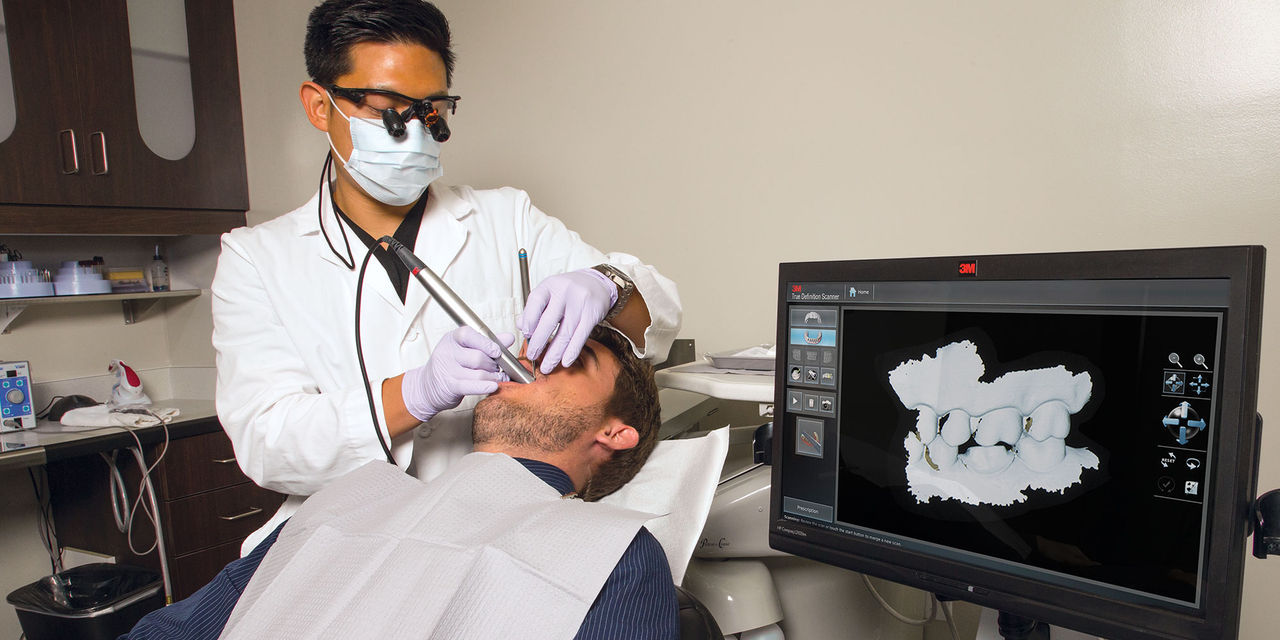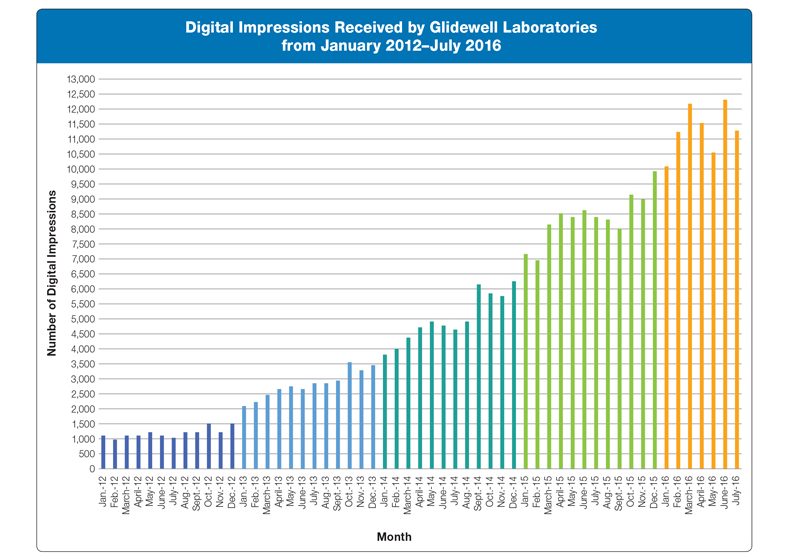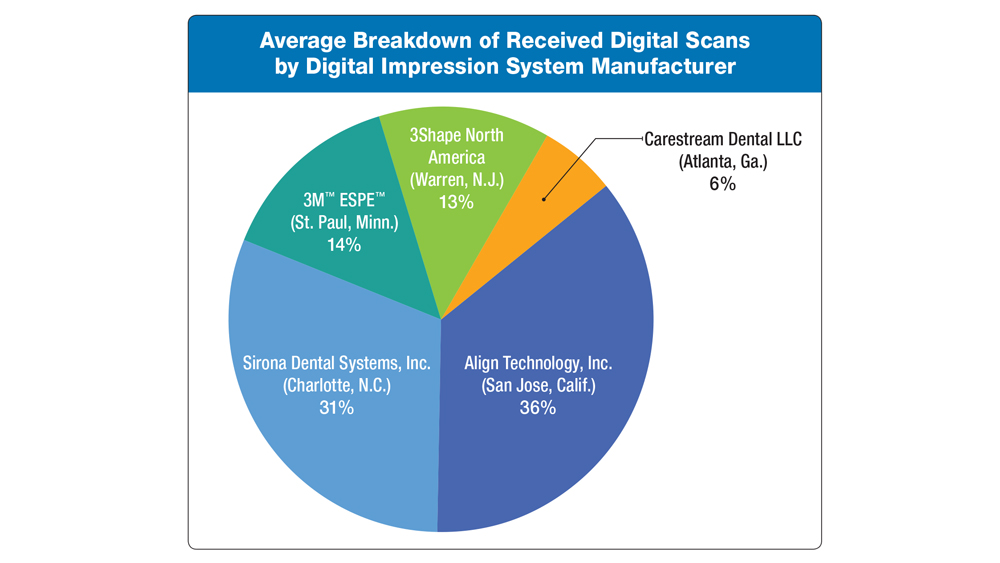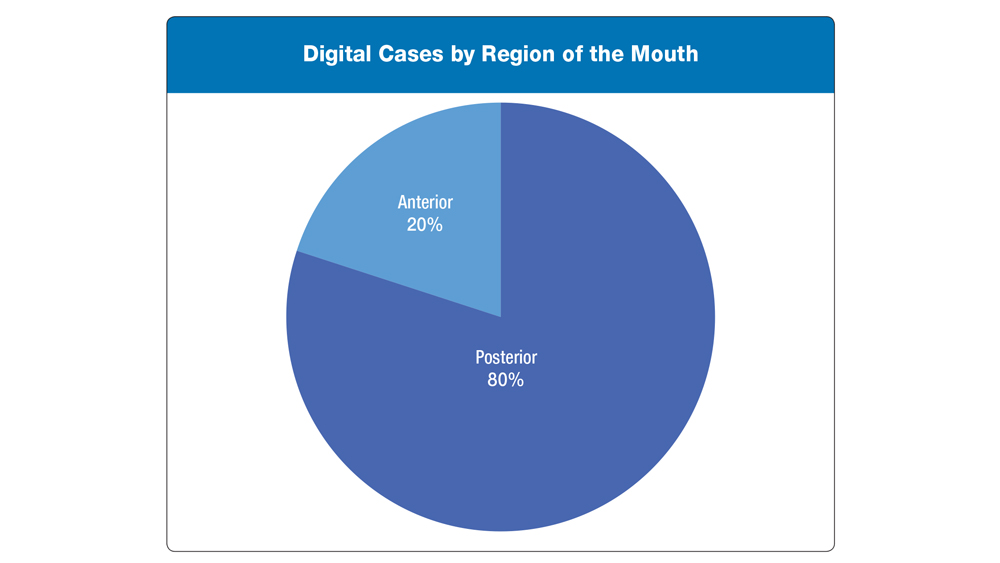Digital Impressions

Intraoral scanners provide clinical advantages that positively impact the success of practicing dentists. This proven alternative to traditional impressions has been shown to achieve higher accuracy in less time.1,2 However, many dentists are understandably hesitant when it comes to the adoption of this technology, which alters the familiar routines of restorative dentistry.
Why Digital Impressions?
Glidewell Laboratories continues to receive more digital impressions each year for all case types (Fig. 1). The growing number shows that dentists are beginning to place trust in the digital process, with some dentists preferring digital impressions for nearly every case — myself being one of them.
I utilize an intraoral scanner in almost every case and have witnessed firsthand the improved accuracy afforded by digital impressions. I find that it saves me time; some systems are able to pick up the preparation, opposing dentition and bite registration in less than a minute, whereas using a triple-tray to gather the same information would take 3–5 minutes. Many of my patients take note not only of my keeping up with modern technology, but also that they no longer have to deal with the often unpleasant experience of traditional impression taking. The less-invasive and relatively delicate nature of digital impressions compared to traditional impressions is better suited for some patients, including those with severe gag reflexes and patients with periodontally compromised teeth.

Figure 1: The number of digital impressions received by Glidewell Laboratories rises each year.

Over two-thirds of the digital scans received by Glidewell Laboratories come from doctors utilizing an intraoral scanner from Align Technology, Inc., or Sirona Dental Systems, Inc.

BruxZir® Full-Strength and BruxZir Anterior account for 75 percent of the digital cases fabricated at Glidewell Laboratories.
When I ask my dental colleagues if they have added this new technology to their practice, many of them say they have considered it, but found the cost of these systems to be a deterrent. While the price of many of these systems can cause a bit of sticker shock, it’s important to understand that the benefits of owning a digital impression system extend beyond increased accuracy and reduced chair time. In addition to the savings in impression material and trays, the cleanup time is only a fraction of what it is with vinyl polysiloxane. Additionally, you will greatly save on shipping costs once you send cases to your lab via the internet, and some laboratories will even provide discounts on digital cases. Intraoral scanners are indeed an investment, but when you combine the immediate benefits with the option to take advantage of additional technological advancements, like chairside milling units, it’s sure to be a wise investment.
Digital Impressions at Glidewell Laboratories
Glidewell Laboratories has made significant investments in digital technologies that improve the accuracy and predictability of dental restorations, and Glidewell technicians are specially qualified to assist clinicians who utilize digital impression systems. Along with enjoying faster turnaround times and saving the cost of one-way shipping to the laboratory, clinicians who utilize digital impression systems also receive the benefit of $20 per-unit savings on BruxZir® Full-Strength, BruxZir Anterior, Obsidian® all-ceramic and IPS e.max® (Ivoclar Vivadent; Amherst, N.Y.) cases; and $40 per-unit savings for Inclusive® Custom Implant Abutments when a model-less restoration is prescribed.

Posterior restorations make up 80 percent of the digital cases sent to Glidewell Laboratories.
Although the majority of impressions sent to Glidewell Laboratories are still taken traditionally, all restorations are fabricated using a digital process, reducing the possibility of human error. Instead of being made into stone models and digitized for the lab’s all-digital workflow, digital scans sent to Glidewell Laboratories are directed to Centralized Digital Order Processing (CDOP), a department created solely for processing digital impressions, composed of skilled technicians who evaluate and prepare the data before it is entered into the production workflow. The four-hour process begins when the files are forwarded to system-specific specialists who are versed in the intricacies of each scanning system’s workflow to ensure all necessary information is included in the scan. From there, the file goes to a technician who checks for inaccuracies, makes sure the bite is aligned, and identifies and verifies margins, contacts and occlusion. Along the way, if a discrepancy is found, a member of the CDOP team will contact the doctor to advise or request a new scan. CDOP also has the ability to manipulate and adjust discrepancies if need be, allowing for a truly personalized experience. After all of the information needed to fabricate a restoration is accounted for and correct, the file is sent into the regular production workflow. This level of quality control corrects potential issues before the impression data enters the workflow, whereas issues with traditional impressions are typically not discovered until a stone model is created.
Conclusion
Digital impression systems should not be thought of as superfluous in the dental practice, but rather as useful tools to improve clinical success and a step toward higher-quality dentistry. Doctors who utilize these systems elevate the quality of health care they provide as well as their own dental expertise. The technology’s ability to improve accuracy and reduce chair time is well-documented, and the widespread adoption of this technology serves to improve health care and the dental industry at large.
Digital impression systems should not be thought of as superfluous in the dental practice, but rather as useful tools to improve clinical success and a step toward higher-quality dentistry.
References
- Ahrberg D, Lauer HC, Ahrberg M, Weigl P. Evaluation of fit and efficiency of CAD/CAM fabricated all-ceramic restorations based on direct and indirect digitalization: a double-blinded, randomized clinical trial. Clin Oral Investig. 2016 Mar;20(2):291-300.
- Patzelt SB, Lamprinos C, Stampf S, Att W. The time efficiency of intraoral scanners: an in vitro comparative study. J Am Dent Assoc. 2014 Jun;145(6):542-51.



